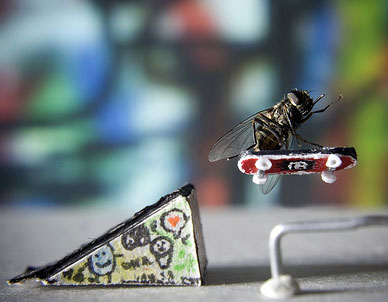Refractograph is the type of photograph that takes the images of light reflections in such a way that I will be captured artistically. The common way to do this is by projecting light through art glass or specially shaped plastic to create that neon-colored works of art. It may look like it is edited or designed digitally in the computer, but its actually real without any camera tricks or anything. Difficult to do as you may think it is, but actually you can make your own refractographs with much simpler materials.
In this craft you’ll basically need the following: a camera with zoom or macro function, tripod, flashlights, LEDs, and assorted light sources, a few pieces of colored paper, and transparent glass or plastic objects.
with zoom or macro function, tripod, flashlights, LEDs, and assorted light sources, a few pieces of colored paper, and transparent glass or plastic objects.
There are other objects to try; nearly anything that is transparent can be used to make refractographs. The only requirement is that for light to pass through that object. Here are a few things you can try: glass bottles or jars, plastic bottles, drinking glasses, glass vases, bottles of water, soda or wine, transparent plastic bead, buttons or toys, glass marbles, and cocktail swizzle sticks.
The best place to set up your working area is in a dark room. There is no need to make it light tight just make sure it’s dark enough to make your reflected lights show up clearly. Now set up your transparent objects in front of a piece of colored paper. Then shine a light through the object onto the paper. Then set your camera up on a tripod to make it stable, zoom in on the light pattern being projected on the paper and click! So basically that’s all there is to do and nothing more. Just let your imagination and creativity take you further. There is no limit to the designs you can create and capture.
In this craft you’ll basically need the following: a camera
There are other objects to try; nearly anything that is transparent can be used to make refractographs. The only requirement is that for light to pass through that object. Here are a few things you can try: glass bottles or jars, plastic bottles, drinking glasses, glass vases, bottles of water, soda or wine, transparent plastic bead, buttons or toys, glass marbles, and cocktail swizzle sticks.
The best place to set up your working area is in a dark room. There is no need to make it light tight just make sure it’s dark enough to make your reflected lights show up clearly. Now set up your transparent objects in front of a piece of colored paper. Then shine a light through the object onto the paper. Then set your camera up on a tripod to make it stable, zoom in on the light pattern being projected on the paper and click! So basically that’s all there is to do and nothing more. Just let your imagination and creativity take you further. There is no limit to the designs you can create and capture.















